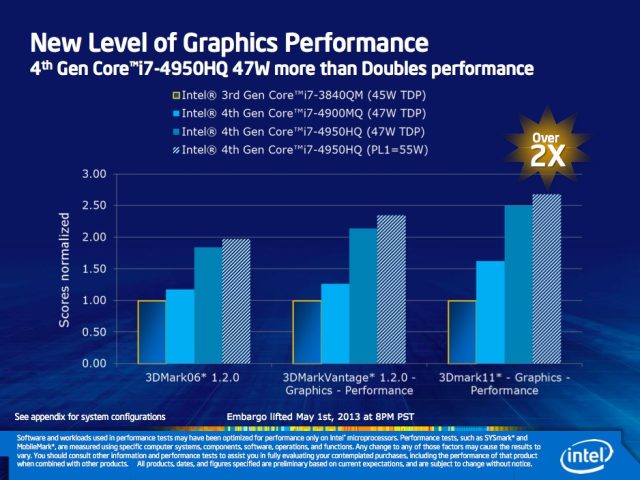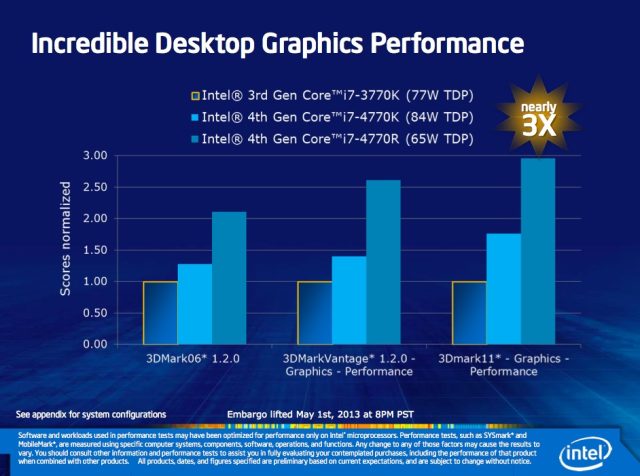
Every year, Intel releases a new line of CPUs: in 2011 we got Sandy Bridge, last year brought us Ivy Bridge, and this year is bringing us Haswell. Each of these new architectures typically increases performance by a bit while consuming the same amount of power (and often less). However, the really interesting thing about Intel's recent processors has been their GPUs, not their CPUs.
The company's graphics improvements since the beginning of the decade have been particularly impressive: pre-Sandy Bridge GPUs were near-useless for high-end gaming, but Ivy Bridge's HD 4000 graphics chip in particular made high-end gaming possible on Intel's GPUs, at least at lower resolutions and settings. This isn't something that you could have said in 2010.
With Haswell, Intel will continue to up its game (and its gaming performance), and the company has just officially announced details about its latest GPUs, the performance that we can expect from them, and the products we can expect them to appear in.
“HD Graphics” becomes “Iris”
Ivy Bridge CPUs can come paired with one of three GPUs: HD Graphics 4000, the highest-performing (and most common) part; HD Graphics 2500, a less performant version of the same architecture that uses six of Intel's graphics execution units (EUs) rather than the HD 4000's 16; and HD graphics, which performs at roughly the same level as the HD 2500 part but removes Intel's QuickSync video encoding feature and a few other video-related capabilities.
Haswell's new GPUs expand the number of performance tiers to five and cover different types of devices, power envelopes, and price points just as Intel's CPU portfolio has continued to grow over the years. The three top-performing parts are the ones that Intel is focusing on today.

We'll start with Ultrabooks, which two of these three GPUs are designed to fit inside. The higher-performing of these two GPUs sheds the HD Graphics moniker for a new name: the Iris Graphics 5100. Intel's 3DMark11 tests show this part as being just over twice as fast as Ivy Bridge's HD 4000 chip, and while we'll actually want to play some games with both GPUs to see how these benchmarks translate to real life, that's an impressive gain.
The one potential wrinkle is that the Iris 5100 is confined to chips with a 28W thermal design power (TDP), which is a fair bit higher than the 17W TDP used by both Sandy Bridge and Ivy Bridge CPUs. We've talked before about how Intel's TDP ratings (and the newer SDP ratings) are a bit nebulous, but it may be the case that these chips are confined to slightly larger (think 13-inch) Ultrabooks because of power or thermal constraints. It's also worth noting that the Ultrabook specifications are always changing, and that Intel can always tweak the specifications to fit a slightly larger, more powerful chip as they deem necessary.
For smaller (and perhaps also cheaper) Ultrabooks, there's the lower-performing of the two Ultrabook parts, called the Intel HD Graphics 5000. Intel's benchmarks show this part as being about 1.5 times as quick as the HD 4000 part, which is still a nice increase given that chips with this GPU fit into a 15W TDP envelope. Note that this chip doesn't use the "Iris" moniker, which Intel is limiting to its fastest GPUs for now.
These are the GPUs we'll probably see the most often, given the prevalence of Ultrabooks in today's PC market, but there's also an even faster GPU intended for larger laptops (think a 15-inch MacBook Pro compared to a 13-inch MacBook Air): the Iris Pro Graphics 5200 GPU is similar to the Iris 5100 in execution resources, but it adds a small amount of integrated eDRAM to the CPU package to increase performance. This performance comes with a fairly heavy power cost—the H-series quad-core processors that use the Iris Pro 5200 have a 47W TDP compared to the dual-core Iris 5100-equipped U-series CPUs' 28W—but this is to be expected, given that you're integrating extra memory on the die and going from two to four cores to boot. As Ars contributor David Kanter writes, this eDRAM should also be usable by the processor cores as another level of cache memory, further increasing CPU performance as well.

Intel benchmarks the Iris Pro 5200 at about 2.5 times faster than the HD Graphics 4000 GPU, which if true puts it in roughly the same league as today's midrange dedicated GPUs. If Intel's partners can incorporate that level of performance into a laptop without also needing to devote extra motherboard space to a dedicated GPU and graphics memory, that opens the door to both smaller laptops and similarly sized laptops with larger batteries.

The Iris Pro 5200 will also be making an appearance in certain desktop CPUs. Just as Ivy Bridge desktop CPUs use an S suffix to denote a lower-TDP chip and a K suffix to denote an unlocked overclocker-friendly chip, Haswell's desktop CPUs will introduce an R suffix to indicate that they use the Iris Pro 5200. The desktop version of the 5200 has a bit more thermal headroom, and thus it ought to be a bit quicker than its laptop counterpart—Intel's 3DMark11 benchmarks rated it nearly 3 times better than its predecessor.
Finally, we get to the bottom two parts in Haswell's GPU lineup. Intel isn't saying much about how these perform relative to the Ivy Bridge parts, but these lower-end chips have always been less about raw 3D performance and more about the API levels and features supported. If past is prologue, the Intel HD Graphics 4600, 4400, and 4200 parts (as well as the server-and-workstation-oriented P4700 and P4600 parts) will likely support the same features as the 5000-series parts, but with less raw 3D performance. The lowest-end part, still called simply "Intel HD Graphics," will likely remain as it is—a basic GPU to be paired with low-end Pentium and Celeron CPUs.
Most of these new Haswell GPUs should support the same general feature set: Direct3D 11.1, OpenGL 4.0, and OpenCL 1.2; a new, faster version of Intel's QuickSync video encoding engine; DisplayPort 1.2, which supports a higher bandwidth than the HD 4000's DisplayPort 1.1; improved support for 2K and 4K resolutions; and something called "three screen collage display," which appears to allow you to stretch one "logical" monitor across up to three physical monitors (AMD and Nvidia have supported a similar feature for several product generations now).
Conclusions: Mo' parts mo' (potential) problems

We'll start with the good: if actual games see the same performance improvements as 3DMark, then Haswell's GPUs will be a significant step up over Ivy Bridge, at least most of the time. The Iris products in particular look to continue integrated graphics' incursion into the low- and mid-end dedicated graphics market, leaving fewer places for dedicated chips from AMD and (especially) Nvidia to hide. Intel's own benchmarks show that performance will likely vary from title to title, though—3DMark11 consistently showed larger gains than 3DMark06 or 3DMarkVantage, for example.
The downside is that this flood of new GPUs further complicates Intel's already-plenty-complicated CPU lineup. Currently, if you're in the market for an Ultrabook it's a sure bet that you'll be getting the HD 4000 GPU most of the time (even if the maximum clock speed of the part can vary by 100MHz or so from CPU to CPU). If you're buying a Haswell system, things aren't as clean-cut. On top of the standard CPU questions—dual-core versus quad-core, Hyperthreading or none, and clock speed, to say nothing of more obscure extensions like TSX—you'll also need to keep track of which GPU you're buying.
It's possible that certain form factors will gravitate toward and informally standardize around certain GPUs—13-inch Ultrabooks around the Iris 5100 and 11-inch Ultrabooks around the HD 5000, for instance—but we won't know that for sure until we've gotten a good look at the first crop of Haswell laptops.
We'll be writing more about Haswell as its launch date nears—Intel's teaser page suggests the official launch will happen on June 3, just before Computex—and as we get our first Haswell systems in for review we'll be paying special attention to just how much its various GPUs improve over the old ones.
Listing image by Intel
reader comments
117